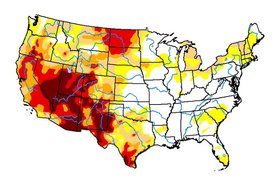As explosive growth of the data center industry continues, and the definition of “sustainable” operations evolves, water management approaches must adapt for long-term reliable operation and stewardship of finite water resources
In part one of this series, we reviewed water management practices and key metrics and performance indicators. In this segment, we will examine the management of water-related risks to data center operations. Water-related risks lead to financial risks due to water supply shortage, water quality changes or the mismanagement of water resources. Water-related risks will vary according to location and water consumption, among other factors.
Categories of water-related risks
Water-related risks can be categorized in several ways, but generally fall into one of three buckets:
- Physical
Water quality and available quantity as well as anticipated trends over time that incorporate historical trends into future projections. This category can contain significant uncertainty due to varying projections of population growth and impacts of climate change (more water, less water, more compressed wet seasons, stronger storms, longer droughts, etc.) on water resources. - Regulatory
New and/or changing regulations that can impact access to water supplies, discharge requirements for wastewaters, and water reuse requirements, leading to increased physical water risks. Stricter regulatory requirements can also draw attention to industry water use, creating perceptions that industry are not good water stewards, leading to reputational water risks. - Reputational
Reputational risks stem from stakeholder perceptions of negative water-related impacts on watersheds, ecosystems, and communities. Reputational concerns can lead to decreased brand value and ultimately threaten a company’s social license to operate.
All of these water-related risks lead to financial risks. The quantification of water-related financial risks and the integration of sustainability and financial reporting is an emerging field with new tools and platforms being developed all the time. A summary of many of the currently available tools is provided on World Wildlife Fund’s “Valuing Water Database” which lists over 100 tools and approaches in use around the world.
Geographic scales of water-related risks
Water supply and quality management has become a core component of many data center operators’ risk management programs. Protecting data centers from operational outage is critical to maintain reliability requirements for which the industry standard is “five nines” or 99.999 percent uptime throughout the year. This translates to a maximum of 5.25 minutes per year of downtime. Key considerations for a robust data center water risk evaluation include:
- Watershed-level
Understanding the supply and demand dynamics within the physical boundaries of the watershed, and the context of data center site water use within it. Looking through the watershed lens, what means of wastewater discharge, use, or reuse is the best “fit” given water quality and quantity? - Utility-level
For both water and wastewater, does sufficient hydraulic capacity exist? Sufficient water rights? What is the condition of existing infrastructure? How does the utility manage their assets? - Site-specific
What degree of redundancy is achievable for both water supply and wastewater discharge? How variable is water quality of supply? How does supply water quality impact use (cycles of concentration) within the cooling system and corresponding water supply demand? How much storage is available onsite if the primary supply or wastewater infrastructure is offline? - Uncertainty
Projection of future trends in climate change, water supply quantity and quality, and growth of population and industry all carry a significant degree of uncertainty. Multiple scenarios and probabilities should be considered to understand the range of potential outcomes and impacts. - Continual refinement
A water risk evaluation should be a living document, revisited and updated at least annually. It should capture how the risks will change over time (i.e., rapidly increasing population demands), what external factors may change the risk profile (e.g., climate change or new regulations), and what is the vulnerability of the operations to natural events (e.g., flood, drought, tornado, etc.).
With careful analysis and planning, water risks, such as loss of supply or change in quality, can be identified and mitigated, preventing impacts to operations.
Changing focus: a watershed view
Understanding and quantifying water use, as well as assessing water risk, are critical steps in developing a risk mitigation plan that serves to support data center operators’ core mission: maintaining high reliability of data center operation.
Read the series:
Data centers often rely on the utilities that serve them to provide continuous water and wastewater services; however, these providers are not contractually beholden to the same reliability commitments as the operators themselves. Therefore, data center operators are increasingly looking beyond their fence lines to consider the broader watershed view and the long-term sustainability of their water use within that context.
The business case for industry to take action towards a 100 percent sustainable water balance (i.e., replenishing water to offset consumptive water use, also known as water neutrality) has been made (Rozza, 2013; Wade, 2021). Many companies (Coca-Cola, The Gap, Pepsico, Intel, Cargill, Starbucks) have recognized that business case and charted a course towards watershed replenishment and restoration of watershed health. In part 3 of this series, we will examine the challenges and opportunities data center operators face as they undertake commitments to water replenishment.
Last Week: Part 1 of 3: Data center water use
Next Week: Part 3 of 3: Watershed replenishment: opportunities and challenges
Rebecca Maco is a project manager and process engineer with over 20 years of experience
Thomas Steinwinder currently leads Brown and Caldwell’s data center & mission critical water business.
Dr Carla De Las Casas is Brown and Caldwell’s data center water leader.





